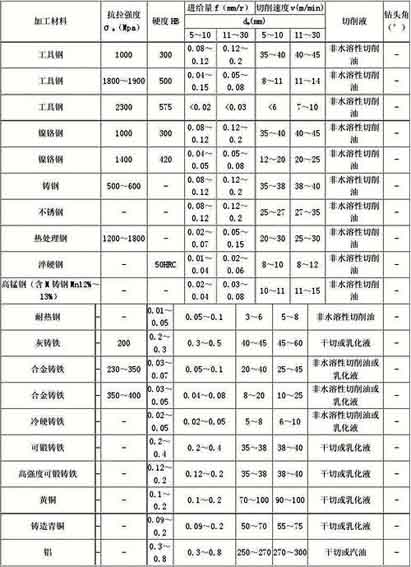Los materiales difíciles de mecanizar son materiales con mala trabajabilidad en torneado y fresado.. El rendimiento de este material es mayor o menor que los indicadores. (media pensión> 250, σb> 1000 MPa, d> 30%, ak> 100 MPa, k <41.8 W. / mk) uno o más, Todos son materiales difíciles de cortar.. También se puede medir por fenómenos en el proceso de corte. (fuerza de corte, corte de calor, desgaste de la herramienta y durabilidad de la herramienta, Calidad de la superficie procesada y control de viruta., etc.).
1. Las propiedades físicas del material.:
1) Conductividad térmica K: El Vc permitido de materiales de alta conductividad térmica es mayor.. Como cortar Vc de los siguientes materiales con herramientas de carburo cementado:
Acero al carbono K=48,2~50,2 W/m?kVc=100~150 m/min
Aleación de alta temperatura K=8,4~16,7 W/m?kVc= 7~60 m/min
Aleación de titanio K=6,3~9,6 W/m?kVc= 15~50 m/min
2) Coeficiente de expansión lineal α: Afecta el grado de expansión y contracción térmica del material y afecta la precisión del procesamiento..

Tabla comparativa de materiales difíciles de mecanizar
2. La composición química del material.:
La composición química y la proporción de materiales son los factores fundamentales que afectan las propiedades mecánicas., propiedades fisicas, rendimiento del tratamiento térmico, Estructura metalográfica y maquinabilidad de materiales.. Como:
do: A medida que aumenta el contenido de carbono de un material, su dureza y resistencia aumentan.
En: Ni puede mejorar la resistencia al calor del material., pero reduce significativamente la conductividad térmica del material.; cuando ni>8%, Se forma acero austenítico., causando un serio endurecimiento laboral.
V: A medida que aumenta su contenido, el rendimiento de molienda del material empeora.
Mes: Puede mejorar la resistencia y dureza del material., pero la conductividad térmica del material disminuye.
W.: Puede mejorar la resistencia térmica y la resistencia a altas temperaturas del material y la dureza y resistencia a temperatura ambiente.. Pero reducirá significativamente la conductividad térmica del material..
Minnesota: Puede aumentar la dureza y resistencia del material y disminuir la tenacidad del material.. cuando mn>1.5%, la maquinabilidad del material se deteriora.
Y: Puede reducir la conductividad térmica del material..
De: El titanio es un elemento que forma carburos fácilmente., y su maquinabilidad también es pobre.
hay cr, oh, S, PAG, norte, Pb, Cu, Al y otros elementos que afectan a la maquinabilidad del material..
3. Propiedades mecánicas de los materiales.:
1) Dureza y fuerza: El material tiene dureza y resistencia moderadas., y su maquinabilidad es relativamente buena. Cuanto mayor sea la dureza y la resistencia., peor es la maquinabilidad. Como normalizar 45 acero: HB200, σb 640 MPa;
apagado 45 acero: HRC45, σb 2100~2600 MPa. También existen finas impurezas en la estructura de los materiales metálicos que afectan la maquinabilidad del material., como A1203, Si02, Ti02 y así sucesivamente. Su microdureza es alta., lo que provoca desgaste mecánico en las herramientas de corte; su maquinabilidad también está deteriorada.
2) Dureza αk y plasticidad δ: Para materiales con alta tenacidad y plasticidad., la resistencia, La deformación y el calor generado durante el corte son grandes., y su maquinabilidad también es pobre.
3) Módulo elástico E: Es un indicador de la rigidez del material.. Un módulo elástico grande significa que el material no es fácil de deformar elásticamente bajo la acción de una fuerza externa.. Sin embargo, el material con un módulo elástico pequeño tiene una gran recuperación elástica durante el proceso de corte, y la fricción de la herramienta es grande, y el corte también es difícil. Como caucho blando E==2~4MP; 45 acero E=200000MPa: Para material E=500000 MPa.
4. La estructura metalográfica del material.:
1) Ferrito: Tiene muy baja dureza y resistencia. (HB50~90, σb =190~250 MPa), alta plasticidad y tenacidad (d=40~50%), y es fácil producir filo acumulado durante el corte. La maquinabilidad es pobre.
2) Perlita: La perlita esférica tiene buena maquinabilidad.. (P.ej. 45 acero)
3) cementita: alta dureza (HRC66-70), pero muy frágil (αk=30-35 MPa), debido al aumento de Fc, es fácil de astillar y dificulta el corte.
4) Los austenitas: su dureza no es alta (sobre HB200), pero su plasticidad y dureza son altas, El endurecimiento de superficies y la soldadura en frío de virutas y herramientas son graves., y la maquinabilidad es pobre. Como 1Cr18Ni9Ti, aleaciones de alta temperatura, etc..
5) martensita: El acero templado pertenece a este tipo de estructura metalográfica.. Tiene alta dureza y alta fragilidad., y su maquinabilidad relativa es 1/3 a 1/10 de eso de 45 acero.
 English
English العربية
العربية 中文(漢字)
中文(漢字) Čeština
Čeština Dansk
Dansk Nederlands
Nederlands Suomi
Suomi Français
Français Deutsch
Deutsch Italiano
Italiano 日本語
日本語 ಕನ್ನಡ
ಕನ್ನಡ 한국어
한국어 Português
Português Русский
Русский Slovenčina
Slovenčina Español
Español Svenska
Svenska Türkçe
Türkçe

